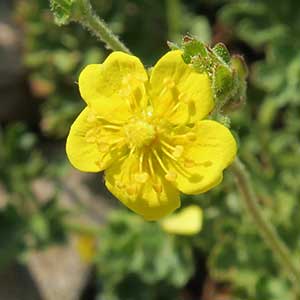Potentilla brevifolia
Potentilla anglica
short-leaf cinquefoil, sparse-leaf cinquefoil
English cinquefoil, potentille d'angleterre, trailing cinquefoil, trailing tormentil, wood cinquefoil
soon becoming prostrate, ± flagelliform, usually openly branched, eventually rooting at some nodes, (0.3–)1.5–7+ dm.
petiole 1–4 cm, eglandular hairs absent or sparse, spreading, less than 1 mm, weak, glands abundant.
± persistent, ternate or palmate, 2–10(–12) cm;
petiole 1–7(–8) cm, long hairs sparse to abundant, appressed, 0.5–1 mm, stiff, glands absent;
leaflets 3–5, central ± obovate to cuneate, 1–3(–3.5) × 0.8–2(–2.5) cm, distal ± 1/2 of margin incised 1/4–1/3(–1/2) to midvein, teeth 2–4 per side, surfaces similar, green, sparsely to moderately hairy.
2–3(–4) proximal to 1st flowering or branching node, usually well expanded at anthesis, usually ternate, 2–6(–10) cm;
petiole 0.3–4(–8) cm;
leaflets (3–)5, ± resembling or narrower than those of basal leaves, narrowly cuneate, 1–2(–3.5) × 0.8–2(–2.5) cm, apex rounded to obtuse.
solitary flowers at stolon nodes.
(1–)3–10(–17) cm.
epicalyx bractlets lanceolate-elliptic to ovate, 2–4 × 0.8–2 mm;
sepals 3–5(–7) mm, apex broadly acute to obtuse;
petals 3.5–6.5 × 3–5 mm;
filaments 1–2.5 mm, anthers 0.5–0.6 mm;
carpels 10–15.
4(–5)-merous;
epicalyx bractlets narrowly elliptic to oblong or ovate, 3–4(–7) × 1–1.5 mm, smaller than to slightly larger than sepals;
hypanthium 2–4 mm diam.;
sepals (3–)4–6 mm, apex broadly acute or acuminate;
petals 6–9 × 5–9 mm, apex ± retuse;
stamens 15–20, filaments 0.8–1.2 mm, anthers 0.8–1.2 mm;
carpels 20–50, styles 0.9–1.5 mm.
1–1.5 mm.
1–1.5(–1.8) mm, ± smooth.
± erect, stout to slender, 1–4 cm.
= 28, 56 (Europe).
Potentilla brevifolia
Potentilla anglica
Potentilla brevifolia is found mainly in alpine situations in the Pioneer, Sawtooth, Smoky, and White Cloud mountains of central Idaho; the Madison Range of western Montana; the Jarbidge Range of northeastern Nevada; the Blue, Steens, and Wallowa mountains of eastern Oregon; and the Teton Range of northwestern Wyoming. The elongate caudices are easily covered by moving soil and talus.
(Discussion copyrighted by Flora of North America; reprinted with permission.)
Potentilla anglica apparently is a product of hybridization involving P. erecta and P. reptans (B. Matfield and J. R. Ellis 1972) that has become stabilized and distinct from both parents. In Europe, it forms back-cross hybrids with both P. erecta (P. ×suberecta Zimmeter) and P. reptans (P. ×mixta Nolte); these hybrids are not known from North America. A garden hybrid supposedly between P. anglica and P. nepalensis Hooker (known as P. ×tonguei Mallett) was found in Allegany State Park, New York, but this was likely cultivated rather than naturalized.
Potentilla anglica probably was introduced even in Newfoundland (A. Kurtto et al. in J. Jalas et al. 1972+, vol. 13), contrary to the view expressed by M. L. Fernald (1950).
The name Potentilla procumbens Sibthorp was previously used for this species; that is a superfluous and illegitimate name.
(Discussion copyrighted by Flora of North America; reprinted with permission.)
- Local floras:
BC,
CA,
OR
- Local Web sites:
CalFlora,
CalPhotos,
Flora NW,
Go Botany,
PNW Herbaria
WildflowerSearch
iNaturalist (observations)
USDA Plants Database
- LBJ Wildflower Center
- SEINet
- Plants of the World Online
- Encyclopedia of Life
- Wikipedia
- Google Image Search


